From theremin kits production and local distribution to transistor invention – the story started the history: synthesizers under the great Moog name initiated the construction of portable, affordable, less energy consuming and much more reliable instruments. That’s how the culture of the 1960s appeared to be hugely influenced. If someone says “moog-like” he probably refers to any classic analog synth without getting into details because this expression makes it clear enough. Robert Moog happened to be the one who’s responsible for typical analog synth fundamentals: he analyzed and systematized the synthesis process coming up with functional units – modules. Working with voltage control Moog constructed a number of signal generating, modificating and controlling modules which could be integrated and affect each other’s functions as well as the functions of external devices.
Thus any retro analog synthesizer comprising VCO, VCA, VCF, envelopes and a ring mod (+ sequencer) might be called a “moog”. Without being a Moog though.
It became commercially popular thanks to Wendy Carlos and the album “Switched-On Bach”; soundtracks to the Clockwork Orange and Shining were composed with the Moog’s help as well. Dick Hyman’s The Minotaur of the 1969 happened to be the first Top-40 Billboard hit streaming Moog’s voices. Such bands as The Doors, The Monkees, The Byrds, Simon & Garfunkel had at least one song featuring new instrument brought by Robert. “Moog” also assisted The Beatles when they arranged their “Abbey Road”.
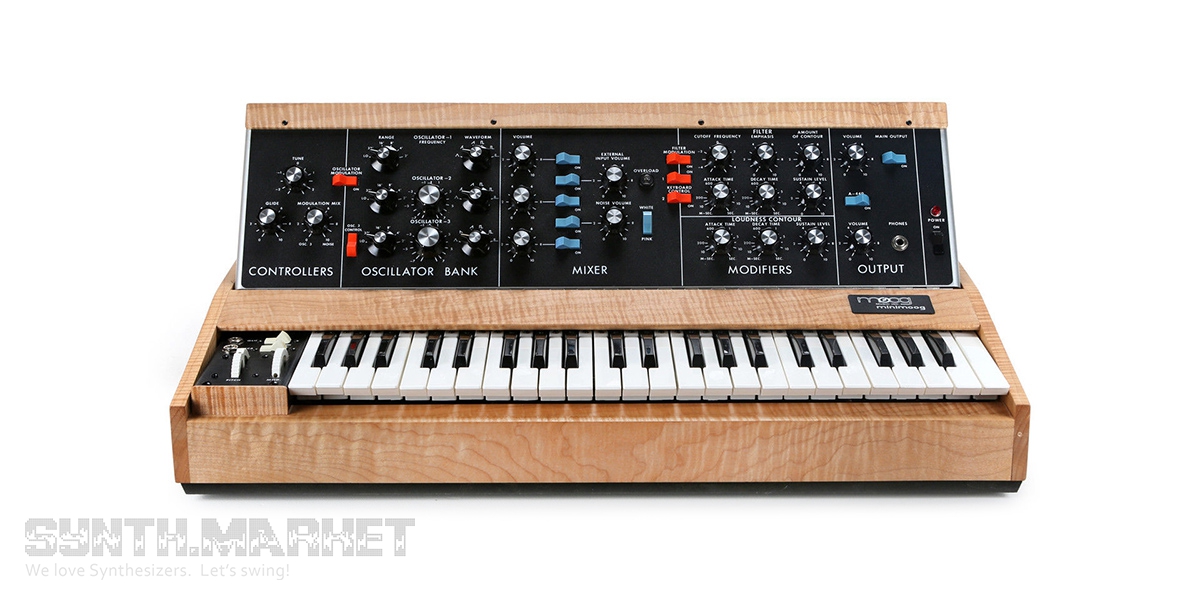 In 1970s another hero emerged – Minimoog which beat Moog module systems with its portability and affordability claiming the right to be called a cult synth. Moog grew up into a mass product which seems surprising today but back then it was natural when a real quality thing gained popularity. The list of moog-consumers was reinforced with Emerson, Lake & Palmer, Tangerine Dream, Kraftwerk, Donna Summer and Beach Boys.
In 1970s another hero emerged – Minimoog which beat Moog module systems with its portability and affordability claiming the right to be called a cult synth. Moog grew up into a mass product which seems surprising today but back then it was natural when a real quality thing gained popularity. The list of moog-consumers was reinforced with Emerson, Lake & Palmer, Tangerine Dream, Kraftwerk, Donna Summer and Beach Boys.
Robert Moog set the V/Oct standard and unlike his competitor – famous Don Buchla – prefered a keyboard type instrument. That’s why right after the progressive concept of Moog modular system there came a godsend for touring musicians – Minimoog. Minimoog is a monophonic analog synthesizer released in 1970 and in 1981 the production was ceased. It incorporated all the advantages of the modular system and got rid of patch cord maze.
That strongly recognizable saturated monophonic sound of Moog is generated with 3 oscillators. Minimoog underwent transformation 4 times: D model retained the filter section but built new oscillators circuitry and contour generators. There was a sufficient choice of switchable waveforms – triangle, saw/ramp, saw/triangle, square and two different pulse waves. Under its panels there is a transistor ladder filter patented by Moog. Third oscillator can be used as an LFO to modulate the pitch and filter cutoff. The envelopes are highly obedient and precise with each pressed note allowing good phrasing. Minimoog also introduced us to the pitch bend and mod wheel (Keith Emerson used to apply pitch bending to his tracks showing the worth of this new feature). Music world definitely crossed the Rubicon – the history added a new page of pre-Moog era. Minimoog took those many hidden studio moments upon the stage making a keyboardist feel himself a “lead guitar”.
24dB filter and relatively unstable tuning of the three VCOs are the reason of that Minimoog’s specific bass sound.
We should note that the increase of budget digital synths and samplers didn’t kill the demand for Minimoogs. It kept on being quite commercially successful.
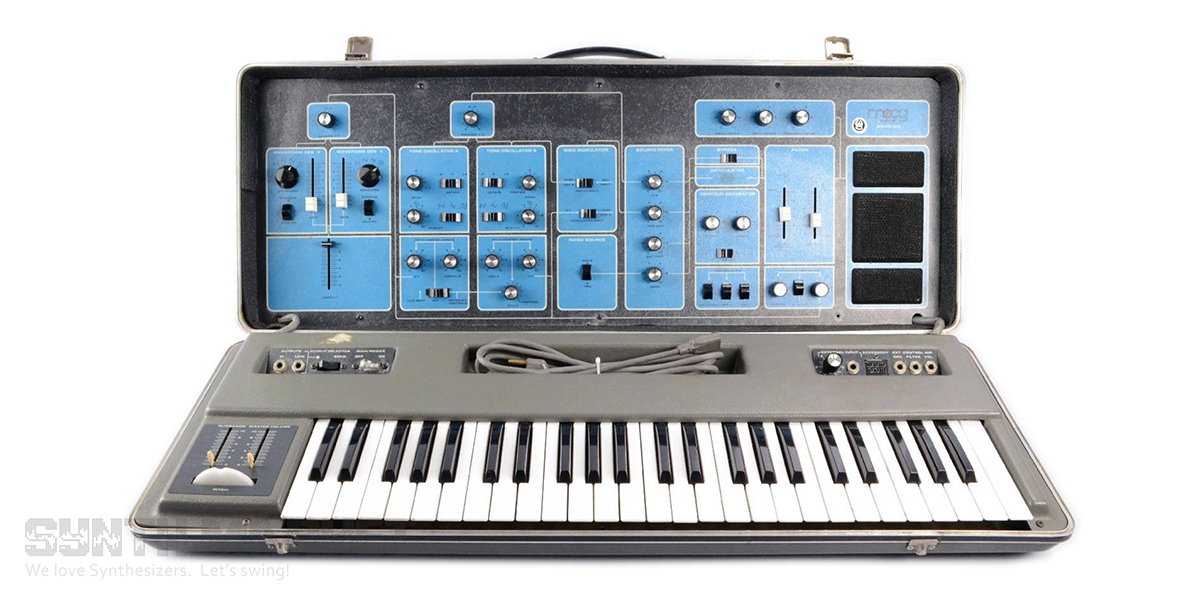 Moog Sonic Six was launched in 1972 by Bill Waytena. That happened after R.A. Moog Inc. and Musonic merger which resulted in a new name for Robert’s company – Moog/Musonics (later Moog Music). Sonic Six was based on Sonic V (Bill’s previous creation produced by his own company) which made the new synthesizer stand out from “moogs”. So why did it seem exceptional? Sonic Six was a duophonic synth with 2 oscillators (3 waveforms each); its 2 independent LFOs had extrinsic control options: X/Y knob is used to mix and balance the LFO outputs. There were also a ring mod and noise generator (white, pink) onboard.
Moog Sonic Six was launched in 1972 by Bill Waytena. That happened after R.A. Moog Inc. and Musonic merger which resulted in a new name for Robert’s company – Moog/Musonics (later Moog Music). Sonic Six was based on Sonic V (Bill’s previous creation produced by his own company) which made the new synthesizer stand out from “moogs”. So why did it seem exceptional? Sonic Six was a duophonic synth with 2 oscillators (3 waveforms each); its 2 independent LFOs had extrinsic control options: X/Y knob is used to mix and balance the LFO outputs. There were also a ring mod and noise generator (white, pink) onboard.
Sonic Six first released units couldn’t stay out of trouble. The products dropped under suspicion, i.e. into that “filter issue” which was incited by Moog claiming that ARP copied their circuitry in Odyssey and 2600. Sonic Six allegedly stole the filter idea from ARP for revenge anyway the lawsuit didn’t follow. Latest models were equipped with traditional Moog filters.They were constructed mainly for home use and appeared to be durable so it’s not that hard to find a unit in good condition now.
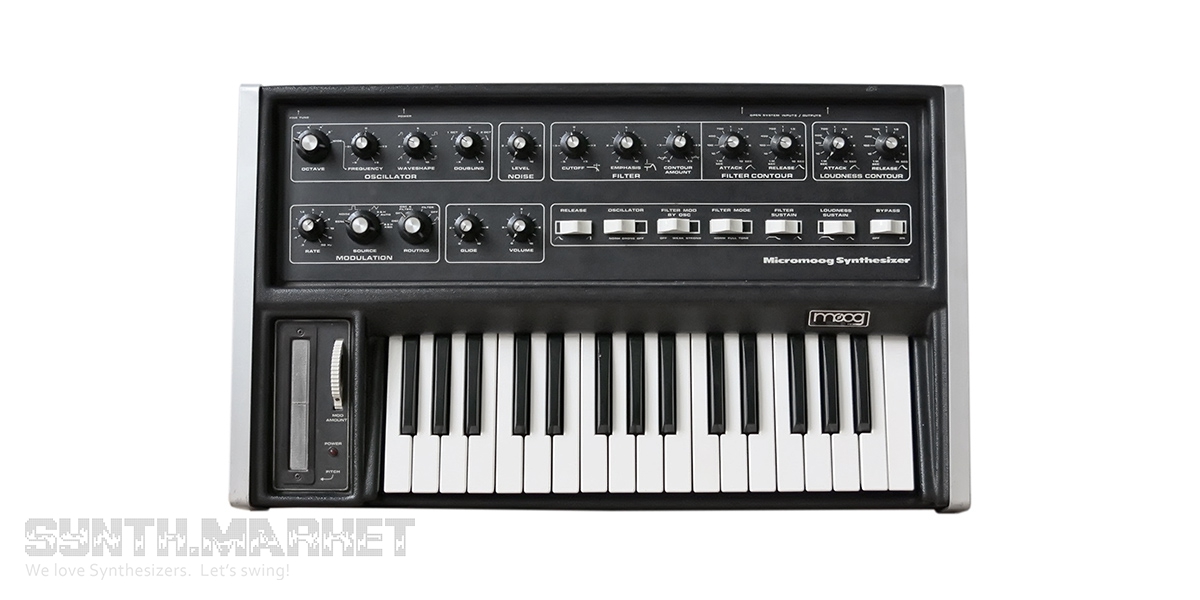 In 1975 Micromoog was launched – a budget Minimoog version. Turning mini into micro didn’t imply any model deterioration of course. Micromoog could be used as a filter processor since it had the same one Minimoog did. The front panel offered a wide range of signal sculpting knobs and a new pitch bend. In 1978 Multimoog was released which had a lot in common except some details like keyboard aftertouch.
In 1975 Micromoog was launched – a budget Minimoog version. Turning mini into micro didn’t imply any model deterioration of course. Micromoog could be used as a filter processor since it had the same one Minimoog did. The front panel offered a wide range of signal sculpting knobs and a new pitch bend. In 1978 Multimoog was released which had a lot in common except some details like keyboard aftertouch.
That same year Polymoog came out. It should have become a part of the Constellation system including polyphonic Apollo, monophonic Lyra and Taurus pedals. Taurus was released separately and other designs were implemented into one machine – Polymoog. Polymoog is a polyphonic preset-based synthesizer with 8 instrument sections. Plus there is a Variation mode which can completely change one of these preset sounds doing magic with all the onboard parameters. LFO allows multi modulation; there are also an original Moog ladder filter built in and key tracking. The keyboard (Pratt & Read, 71 notes, weighted and velocity sensitive) is divided into 3 zones with a volume slider per each. Fully controllable envelope generators, 3-band equalizer, sample and hold, pitch controller ribbon. “Polymoog” usually means “Polymoog 203a” model but in 1978 an affordable (although stripped-down) version called Polymoog 280a featuring a bigger choice of the presets came out – so it obviously wasn’t as flexible as the predecessor easing up its functionality.
One of the instruments in creation of which Robert hardly took any part was Moog Prodigy. It was produced in 1979 and appeared to be an entry-level monosynth growing into a popular bass machine which was frequently used in techno. Prodigy comprised 2 oscillators which could be synced, waveforms wich could be detuned any way you liked – from fat pads to atonal sounds. Prodigy emitted a huge range of synth voices – from timid whistle to deep sub bass. Prodigy not only came to Liam’s mind when he was thinking how to call his band but also drew attention of many other music acts that hit the 1990s: Massive Attack, Fatboy Slim, 808 State as well as Depeche Mode and ever-experimenting Blur.
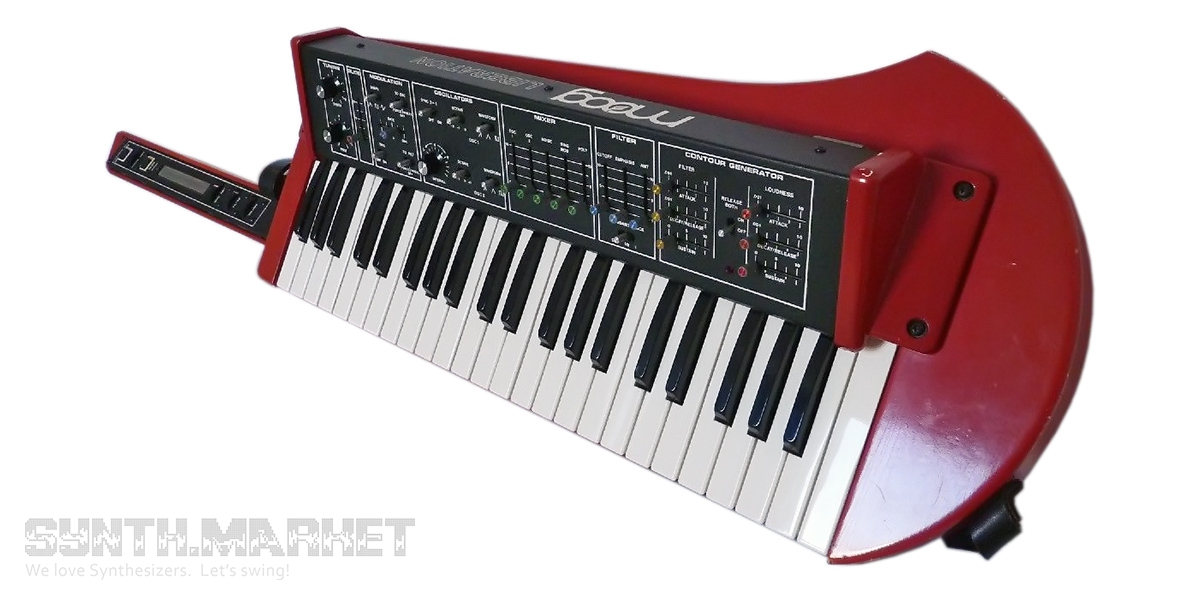 Moog Liberation was produced in 1980 and became one of the most commercially successful keytars. That’s how Moog put keyboardists up on stage. Liberation structure includes 2 monophonic oscillators and a polyphonic section resposible for organ sound generation. There are two ADSR envelopes and one VCF with the mod depth setting ability as well as resonance and cutoff settings. You can find pitch controller ribbon, mod wheels, cutoff and volume on its neck. Power supply came separately in a rackmount box with CV/Gate outputs in order to handle the keytar without too much exertion.The fact that Liberation keytar was of great renown is not an exaggeration: Tom Coster who used to play with Santana, “new wave heavy metal” UFO, Joy Electric, Herbie Hancock and The Human League (“Being Boiled” and “Circus of Death” at Wickerman Festival).
Moog Liberation was produced in 1980 and became one of the most commercially successful keytars. That’s how Moog put keyboardists up on stage. Liberation structure includes 2 monophonic oscillators and a polyphonic section resposible for organ sound generation. There are two ADSR envelopes and one VCF with the mod depth setting ability as well as resonance and cutoff settings. You can find pitch controller ribbon, mod wheels, cutoff and volume on its neck. Power supply came separately in a rackmount box with CV/Gate outputs in order to handle the keytar without too much exertion.The fact that Liberation keytar was of great renown is not an exaggeration: Tom Coster who used to play with Santana, “new wave heavy metal” UFO, Joy Electric, Herbie Hancock and The Human League (“Being Boiled” and “Circus of Death” at Wickerman Festival).
Realistic Concertmate MG-1 was produced by Moog Music, distributed by Radio Shack retailer and released under their brand name Realistic. The design was developed by Paul Schreiber from Tandy Systems Development. Tandy Corporation released a huge batch of MG-1s and at a quite low price. Concertmate MG-1 didn’t feature Moog’s standard pitch bend and mod wheel (which actually seemed a slight advantage because LFO could independently modulate VCO and VCF). It was aimed at mass audience and turned to be a common model among “moog” owners.
The polyphonic section was tuned independently functioning as a third oscillator which contributed to achieving more complex sounds than those other 2-oscillator synths could generate. Polyphony which passed through the only 24dB filter could give paraphony and at that moment not many instruments besides MG-1 were capable to offer the combination of a paraphonic poly-section and monophonic synthesizer in one device. Another peculiarity is a partial dependence of polyphony from contour generators – poly tones feel atack and decay but ignore the release stage. Nevertheless despite some limitations including the absence of vibrato all 32 notes of the polyphony can be heard simultaneously.
MG-1 was created in order to feature that Moog bass but at a lower price and many musicians appreciated this healthy proportion: 808 State, No Doubt, Peter Gabriel, KMFDM, Clues used to like it a lot.
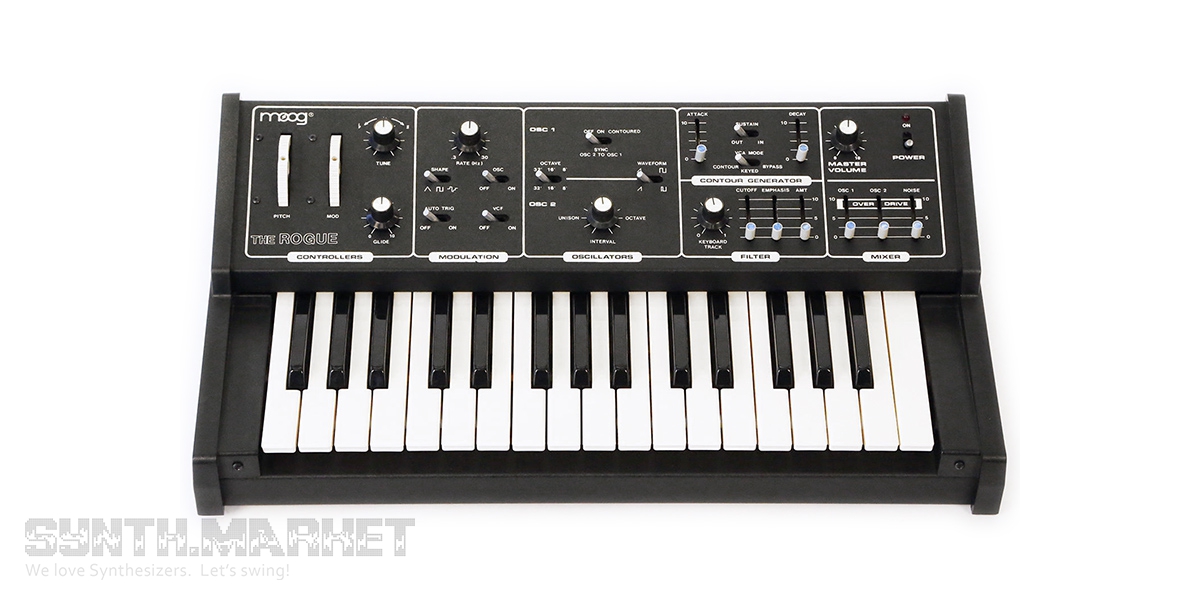 Monophonic Moog Rogue included 2 VCOs which could be tuned in a manner which allowed them to generate similar atonal sounds Moog Prodigy did. On the whole Rogue reminds of MG-1 although Schreiber added pitch/mod wheels, removed poly-section, opted to have an external power supply. There’s also no “Bell Tone” and both oscillators are identical – again unlike MG-1 featured. Rougue is not that flexible instrument everybody wants to buy and enjoy for a long long time because there’s no patch programming ability, the filter and amp are too simple, anyway considering the price and dimensions it’s worth noting that the factory made it properly pre-patched.
Monophonic Moog Rogue included 2 VCOs which could be tuned in a manner which allowed them to generate similar atonal sounds Moog Prodigy did. On the whole Rogue reminds of MG-1 although Schreiber added pitch/mod wheels, removed poly-section, opted to have an external power supply. There’s also no “Bell Tone” and both oscillators are identical – again unlike MG-1 featured. Rougue is not that flexible instrument everybody wants to buy and enjoy for a long long time because there’s no patch programming ability, the filter and amp are too simple, anyway considering the price and dimensions it’s worth noting that the factory made it properly pre-patched.
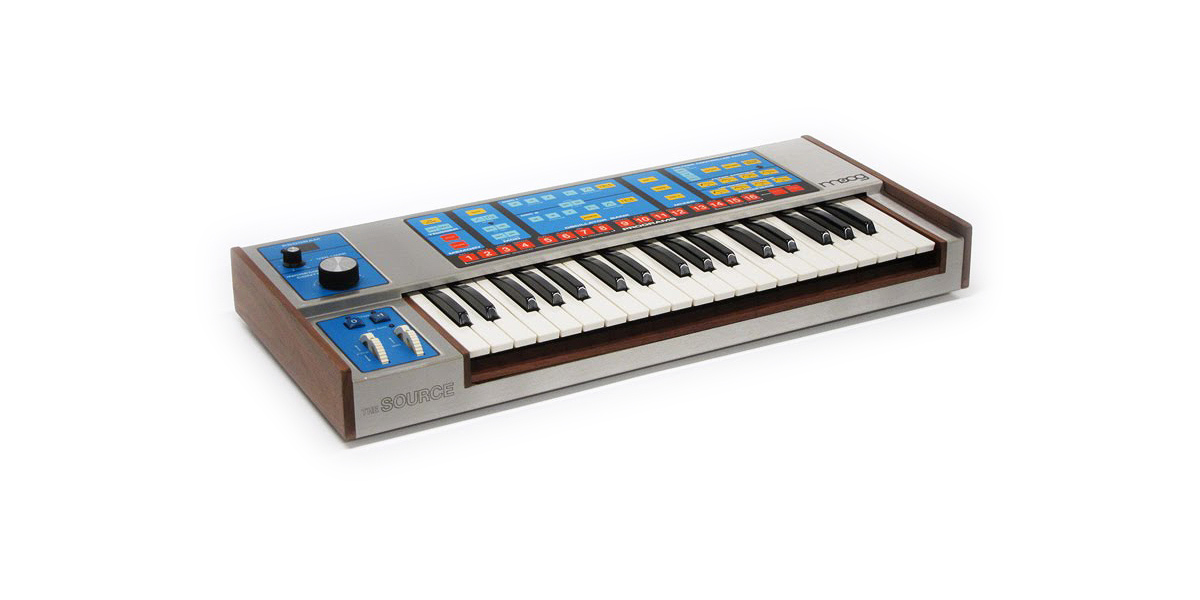 In 1981-1985 Moog put into production quite an atypical instrument – Moog Source. It was a monophonic analog synth with Z80 microprocessor control and membrane keyboard and it was also the first “moog” to offer patch memory (16 presets could be stored onto a cassette). It was also the first “moog” to sound like Minimoog (as close as possible). 2 VCOs offered 3 waveforms and 3 octaves. 24dB VCF let you access resonance and cutoff settings, key tracking and envelope control. Source offered LFO and sample&hold, one of the two ADSR envelopes was assigned to the filter or amplifier. There was also a sequencer featured. Later Encore Electronics would launch Source version with MIDI implementation and increased memory. Source can be distinctly heard in New Order’s “Blue Monday”. Jamiroquai, Depeche Mode and Devo also put it to good use.
In 1981-1985 Moog put into production quite an atypical instrument – Moog Source. It was a monophonic analog synth with Z80 microprocessor control and membrane keyboard and it was also the first “moog” to offer patch memory (16 presets could be stored onto a cassette). It was also the first “moog” to sound like Minimoog (as close as possible). 2 VCOs offered 3 waveforms and 3 octaves. 24dB VCF let you access resonance and cutoff settings, key tracking and envelope control. Source offered LFO and sample&hold, one of the two ADSR envelopes was assigned to the filter or amplifier. There was also a sequencer featured. Later Encore Electronics would launch Source version with MIDI implementation and increased memory. Source can be distinctly heard in New Order’s “Blue Monday”. Jamiroquai, Depeche Mode and Devo also put it to good use.
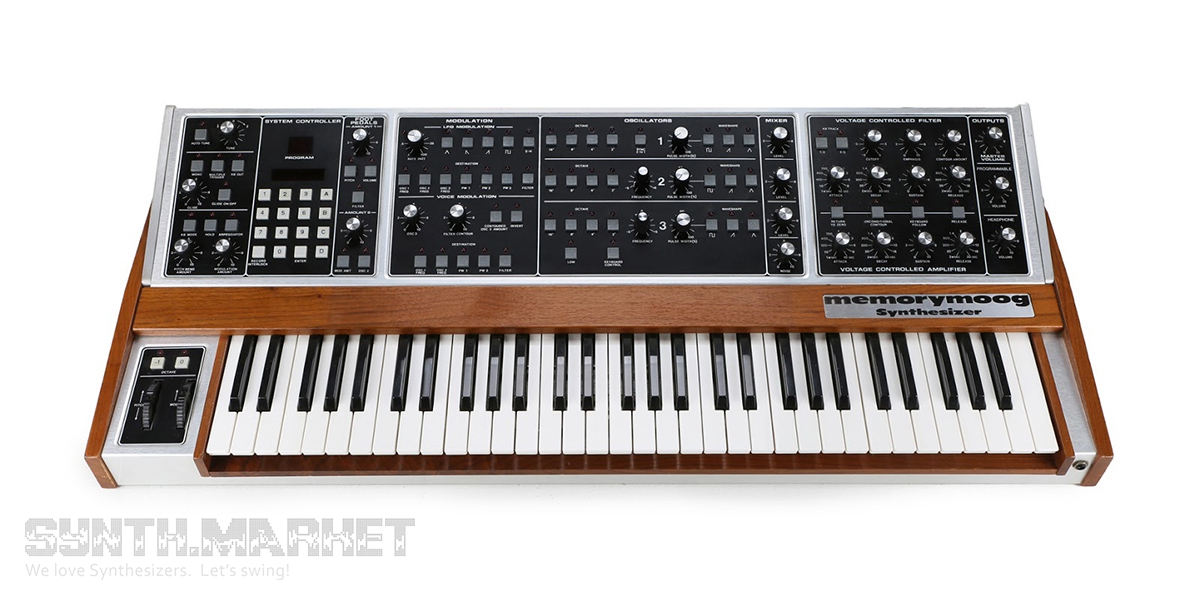 Memorymoog (1982) became the last synthesizer produced by Moog Music (which soon happened to be the victim of the merger and was renamed into Moog Electronics). Each of the 6 voices is generated with the three VCOs and passes through the patented transistor ladder filter. Mono mode allows to have all the 18 produced voices in unison which creates powerful lead and bass. The third VCO could serve as a low- or audio-frequency modulation source. VCO №3 when applied like this could give convincing pseudo-acoustic and FM textures which analog subtractive synthesis never delivered.
Memorymoog (1982) became the last synthesizer produced by Moog Music (which soon happened to be the victim of the merger and was renamed into Moog Electronics). Each of the 6 voices is generated with the three VCOs and passes through the patented transistor ladder filter. Mono mode allows to have all the 18 produced voices in unison which creates powerful lead and bass. The third VCO could serve as a low- or audio-frequency modulation source. VCO №3 when applied like this could give convincing pseudo-acoustic and FM textures which analog subtractive synthesis never delivered.
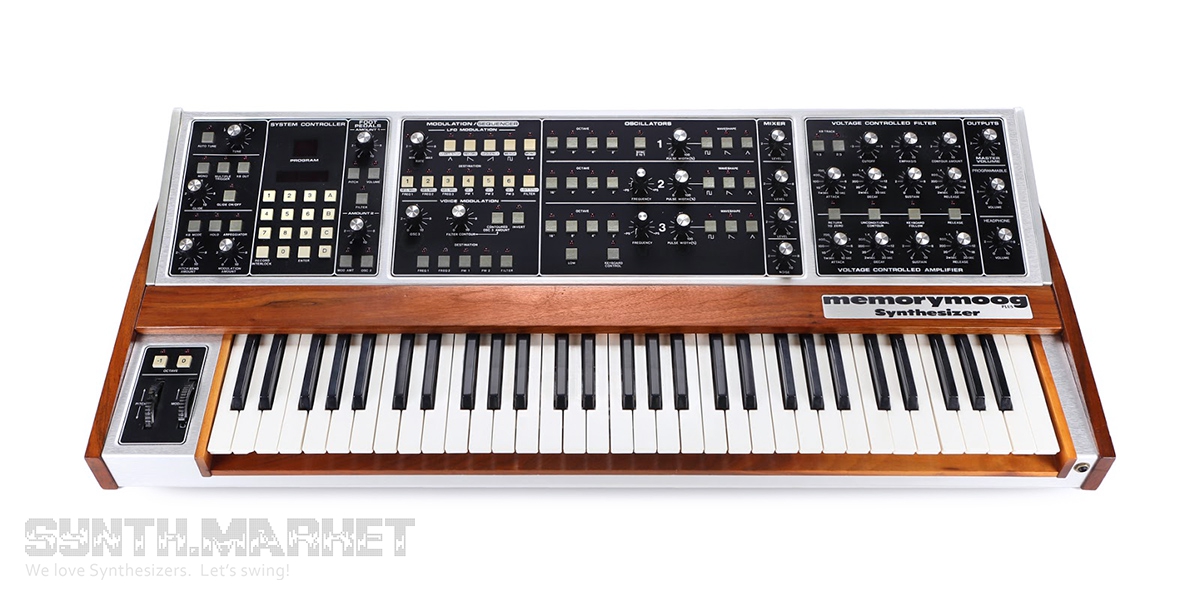 Memorymoog Plus went through some modifications and the main one was introduction of MIDI. Although many users complained about Z80 microprocessor poor integration with new add-ons (like sequencer, for example) and opted for the original model.
Memorymoog Plus went through some modifications and the main one was introduction of MIDI. Although many users complained about Z80 microprocessor poor integration with new add-ons (like sequencer, for example) and opted for the original model.
In 2002 Moog Music brand name rights were returned to the founder and that same year Minimoog Voyager was created becoming a modern day Minimoog. Voyager brought Robert back to actual work. Voyager offers 6 sound sources: 3 VCOs with switchable waves, noise generator, external input (goes through the mixer with individual control of each source and then goes through the filter and amp with the assigned ADSR envelopes) and the sixth one – filter self-oscillation. Plus to Minimoog features Voyager could store 128 presets, had a full-fledged LFO, 2 mod busses affecting every sound parameter, velocity sensitive keyboard with aftertouch, 14 VC Ins and MIDI in/out.
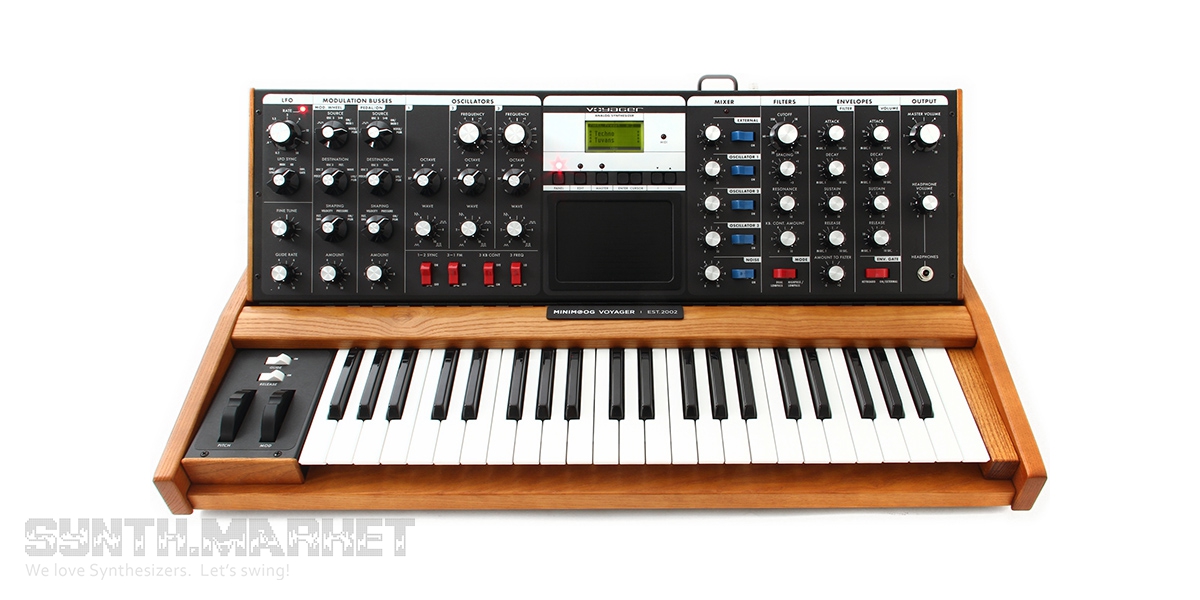 Minimoog Voyager excels the predecessor at stability (oscillators) and has a bigger number of programming possibilities.
Minimoog Voyager excels the predecessor at stability (oscillators) and has a bigger number of programming possibilities.
Besides the classic one there were also its rack version, Electric Blue, Select Series, Old School and XS launched.
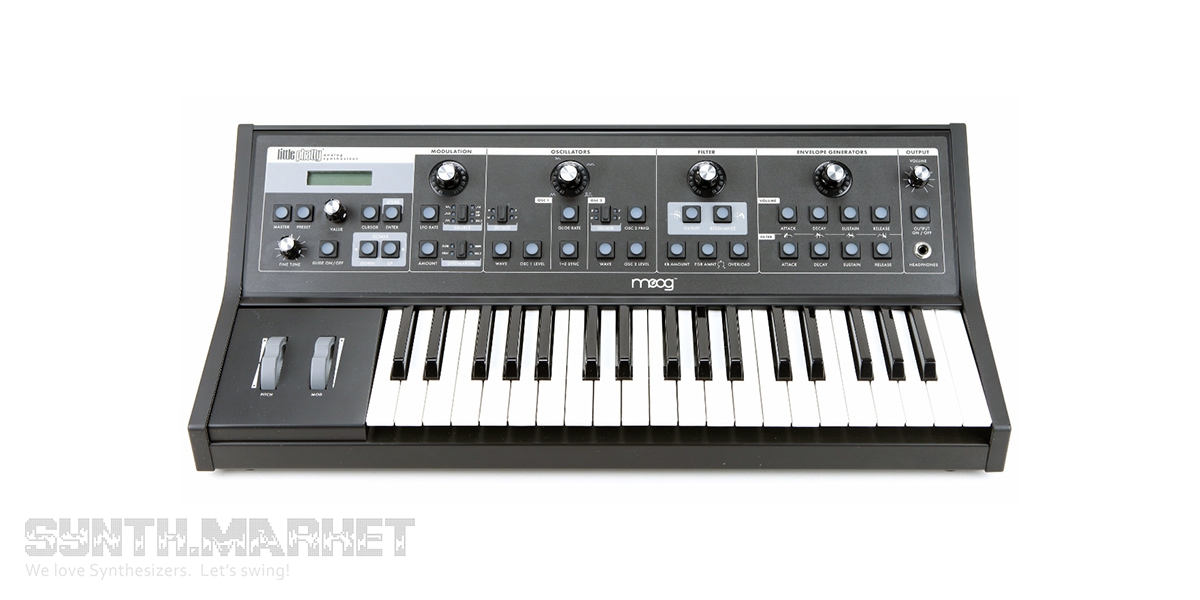 The last design made by Robert Moog was Little Phatty the production of which began in 2006 and stopped in 2013. It was one of a few Moog synthesizers which came out already having MIDI fitted up. Little Phatty is a monophonic dual-oscillator with the variable waveform selector and oscillator sync. The filter is a classic Moog ladder type. LFO offers 6 waveforms, four destinations and rate/depth control. Stage model is considered to be the original one though maybe not so multifunctional but featuring its key qualities – true Moog sound and super stable analog filling. Despite the severe competition Little Phatty is still one of the best options if you need to get really good bass and lead sounds or achieve desired effects and noises.
The last design made by Robert Moog was Little Phatty the production of which began in 2006 and stopped in 2013. It was one of a few Moog synthesizers which came out already having MIDI fitted up. Little Phatty is a monophonic dual-oscillator with the variable waveform selector and oscillator sync. The filter is a classic Moog ladder type. LFO offers 6 waveforms, four destinations and rate/depth control. Stage model is considered to be the original one though maybe not so multifunctional but featuring its key qualities – true Moog sound and super stable analog filling. Despite the severe competition Little Phatty is still one of the best options if you need to get really good bass and lead sounds or achieve desired effects and noises.
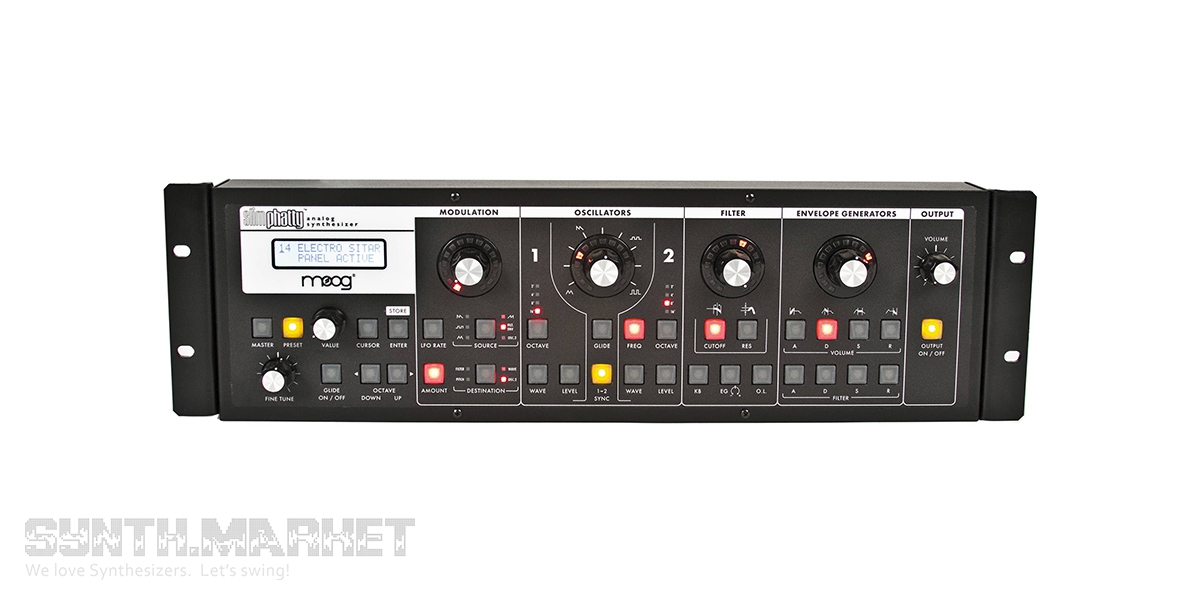 Slim Phatty became the first Moog which offered USB and also could be called another entry-level Moog instrument. It’s based on Little Phatty and can serve as a MIDI controller providing out/in/through. There are two oscillators, settings multicontrol and a traditional ladder filter. It’s really close to Little Phatty but lacks a keyboard and pitch/mod wheels. It sports “Overload” control at the filter stage.
Slim Phatty became the first Moog which offered USB and also could be called another entry-level Moog instrument. It’s based on Little Phatty and can serve as a MIDI controller providing out/in/through. There are two oscillators, settings multicontrol and a traditional ladder filter. It’s really close to Little Phatty but lacks a keyboard and pitch/mod wheels. It sports “Overload” control at the filter stage.
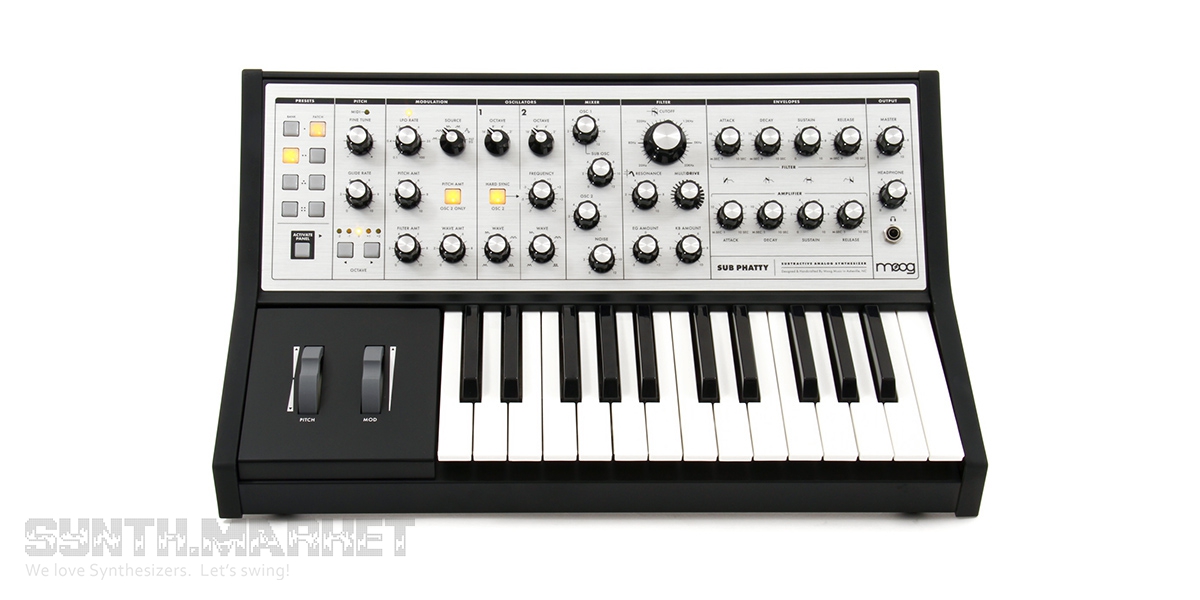 Sub Phatty came out in 2013 and seemed to be a power couple combo: vintage “moog” foundation and a progressive machine producing thick, punchy sounds full of harmonics. Sub Phatty sports new Multidrive filter section circuit which is responsible for asymmetrical distortion and nervous saturation. Square wave sub, two variable waveshape oscillators and noise generator let you enjoy this deeply piercing bass.
Sub Phatty came out in 2013 and seemed to be a power couple combo: vintage “moog” foundation and a progressive machine producing thick, punchy sounds full of harmonics. Sub Phatty sports new Multidrive filter section circuit which is responsible for asymmetrical distortion and nervous saturation. Square wave sub, two variable waveshape oscillators and noise generator let you enjoy this deeply piercing bass.
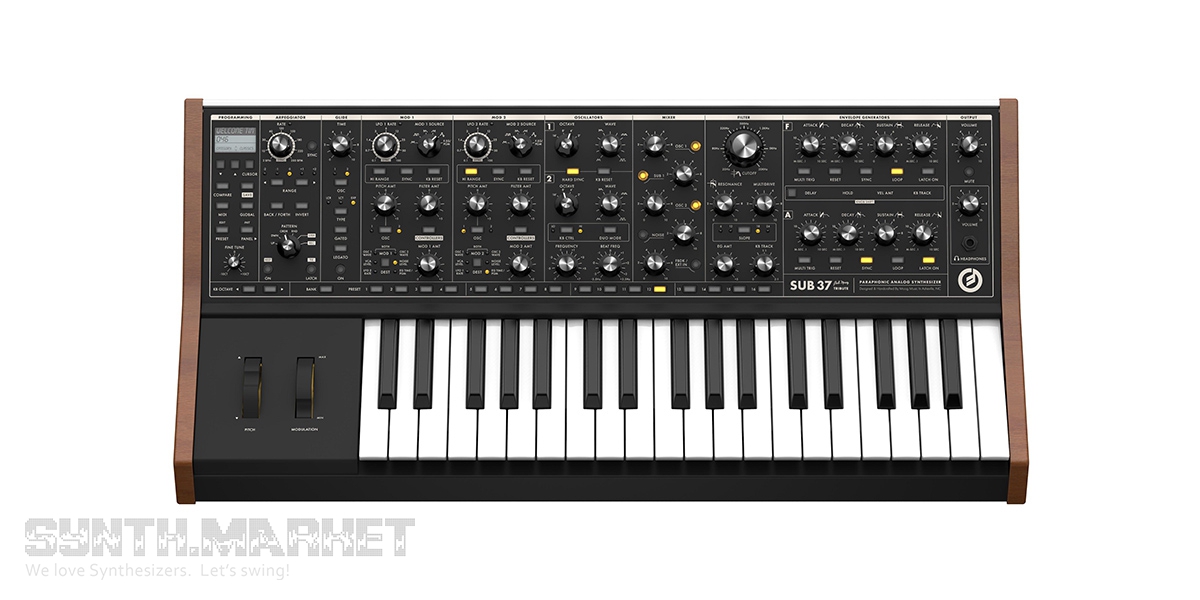 Sub Phatty was surely the most daring instrument of the company but none of the Moog synths could roar with such excitement as Sub 37 did when it came out a year later. 2 VCOs operate in mono and paraphonic modes. The power of Sub 37 is in its sub oscillator and noise generator as well as in external sources possibilities and 2 LFOs with 4 variable waveforms. Analog filter (6, 12, 18, 24dB) is digitally controlled and there’s also Multidrive featured.
Sub Phatty was surely the most daring instrument of the company but none of the Moog synths could roar with such excitement as Sub 37 did when it came out a year later. 2 VCOs operate in mono and paraphonic modes. The power of Sub 37 is in its sub oscillator and noise generator as well as in external sources possibilities and 2 LFOs with 4 variable waveforms. Analog filter (6, 12, 18, 24dB) is digitally controlled and there’s also Multidrive featured.
Moog has a fabulous history and numbers many remarkable ideas including analog effect pedals Moogerfooger or widely known Taurus inspired with classic organs.
In 2015 Moog announced that they were going to revive their modular system according to the circuitry they provided in the 1970s and later Moog presented a limited series of Moog System 55, Moog System 35 and Moog Model 15.
